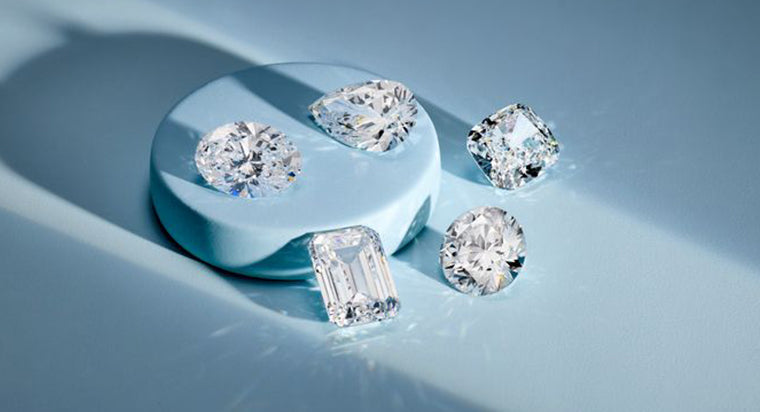Lab Grown Diamonds: A Look into the Production Process

You've probably heard about lab diamonds because they're popular and present everywhere, but you might not know what goes into producing them. It's an innovative process that continues to perfect lab made diamonds. Learn about all that goes into creating stunning lab grown diamonds. With their increasing popularity, it's important for consumers and the industry to be informed about lab diamond production.
TABLE OF CONTENTS
The Basics of Lab Grown Diamonds
Lab diamonds and mined diamonds have the same optical, physical, and chemical properties, so they look exactly the same to the naked eye. The difference is that one is made in a lab, and the other is mined from the Earth. The first successful production of a lab grown diamond was achieved by General Electric (GE) in 1954, using a high-pressure, high-temperature (HPHT) method that mimicked the natural conditions under which diamonds form deep within the Earth. Since the 1950s, the production process has continued to improve to create gorgeous lab diamonds.
Methods of Production
Two well-known methods for creating diamonds are High Pressure High Temperature (HPHT) and Chemical Vapor Deposition (CVD). Let's look at each of these closer.
The High Pressure High Temperature (HPHT) creates lab grown diamonds by replicating the natural conditions under which diamonds form in the Earth's mantle. It involves subjecting carbon material to extremely high pressures (over 5 GPa) and temperatures (above 1,300°C) to transform it into a diamond. The HPHT process starts with a small diamond seed crystal, placed in a growth chamber with a carbon source–typically graphite. The chamber is then exposed to the high-pressure, high-temperature environment, where the carbon atoms dissolve into a molten metal catalyst and slowly precipitate onto the seed crystal, forming a larger diamond. The growth cycle can last several days to weeks, depending on the desired size of the final diamond. After growth, the diamond is cooled slowly to prevent cracking. The final product undergoes cleaning and cutting to achieve the desired shape and clarity.The Chemical Vapor Deposition (CVD) method creates lab diamonds by depositing carbon atoms onto a substrate from a carbon-rich gas mixture in a vacuum chamber. The CVD process begins with a substrate, usually a diamond seed crystal, placed inside the vacuum chamber. A mixture of gasses, typically methane, and hydrogen, is introduced into the chamber. Then, the gasses are ionized using microwaves or a hot filament to create a plasma. The ionization breaks down the methane gas, which releases carbon atoms that precipitate onto the substrate. These carbon atoms then arrange themselves in a crystalline structure, layer by layer, to eventually form a diamond. The diamond grows gradually as the process continues, which can take several days or weeks, depending on the desired size and quality of the diamond. After growth, the diamond is removed from the chamber, cleaned, and cut to the required specifications.
Key Differences Between HPHT and CVD
You might be wondering how these two processes compare. The CVD method tends to produce diamonds with fewer impurities and higher consistency in color, making it ideal for high-quality jewelry-grade diamonds. It allows for greater control over the growth environment, which can result in fewer inclusions. However, the CVD process is typically slower and more expensive due to the advanced technology required. On the other hand, HPHT diamonds can be produced more quickly and at a lower cost, making this method suitable for industrial applications where large quantities of diamonds are needed, such as in cutting tools and abrasives. Some HPHT diamonds contain metallic inclusions from the metal catalyst used in the process, which can affect their clarity and color. Generally, CVD diamonds are preferred for jewelry because of their superior quality and aesthetic appeal, while HPHT diamonds are commonly used where the presence of inclusions is less critical.
Quality and Characteristics
Because they have the same qualities, both mined and lab diamonds are graded using the 4 Cs (cut, color, clarity, and carat weight). Cut refers to the precise facets as well as the shape of the diamond (princess, oval, round, pear, etc.). Color refers to the overall hue or lack of hue within the diamond, and clarity means the inclusions within the stone. Carat weight is the overall size of the diamond–some cuts are heavier than others, so two one-carat diamonds can look different depending on their shape.
Environmental and Ethical Considerations
Lab diamond's extra benefits have helped increase their popularity and allure. They're sustainable because they're created in a controlled environment rather than mined from the Earth. Mining uses a tremendous amount of natural resources and alters ecosystems. Some men and women appreciate the ethical advantages of lab diamonds because they're not involved in the conflict of the diamond industry and support ethical labor practices.
Market Trends and Consumer Preferences
All types of jewelry feature lab diamonds – engagement rings, wedding rings, earrings, bracelets, and necklaces. Lab diamond popularity continues to skyrocket because more consumers are interested in lab diamond benefits and want to support the innovative, sustainable, and ethical future of the jewelry industry.
Lab diamonds cost less than mined diamonds because their supply chain is shorter, and production uses less money. Generally, lab diamonds can be 30-40% less expensive than mined diamonds of comparable size, cut, color, and clarity. This important benefit is also appealing to consumers.
Future of Lab Grown Diamonds
Technological advancements continue to improve lab diamond production. It has allowed the production of larger lab grown diamonds because early technology limited the size. Now, they can be generated in larger carat weights, and this continues to increase the number of choices available to consumers.
The future for lab diamonds is bright. In 2022, the global lab diamond market was valued at $24 billion and is estimated to reach $59.2 billion by 2032, according to Allied Market Research.
Conclusion
Technology and time have improved the production of lab diamonds, and helped increase their popularity. The demand for lab diamonds will continue to grow and production will continue to improve. Lab diamond quality has drastically changed since its invention in 1954. Lab and mined diamonds share the same properties so they're also graded similarly. As a consumer, you have thousands of lab diamond options in different grades and price points. Plus, lab diamonds are ethically sourced, sustainable, and budget-friendly. The importance of these values will only increase over time, and more consumers will seek lab grown diamonds for their jewelry.









